|
|
|
Company History
|
The firm started trading in 1946, when David Clarkson and his
partners bought out a small local carrier called M/ S J
Ramsay. Fortunately because of the modest size of the fleet,
they managed to avoid becoming part of British Road Services (BRS).
David Clarkson eventually bought out his partners and assumed
sole control of the business. The companys original vehicles
were a second-hand Dodge and a Leyland Cub which had already
been in service for many years. They were gradually replaced
with Bedford O models rated at either five or seven tons.
These were mainly used to collect milk from the surrounding
farms, before delivering the 10 gallon churns to the St
Cuthberts (Co-op) dairy in Edinburgh.
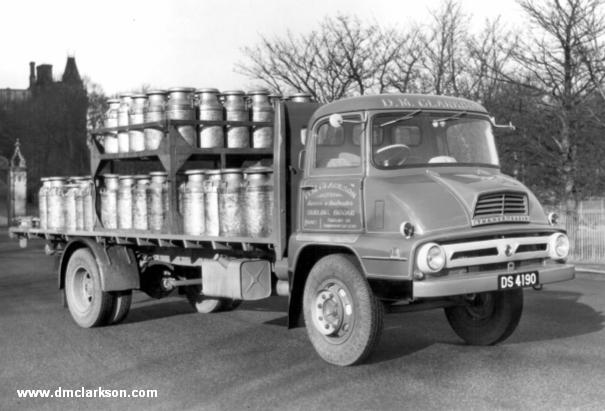
The number of runs varied throughout the year and usually increased
during the summer months when the cows were allowed outdoors.
During those months a double deck removable steel frame placed
over the drive axle to increase the load capacity was used.
Occasionally a second smaller frame was placed at the front,
but the lack of power steering made this unpopular with the
drivers.
The milk contract was labour intensive; the empty churns had
to be drained and washed at the dairy in Edinburgh, before
being re-loaded for the haul back to Biggar. They then had
to be exchanged at the correct farm the following morning.
Furthermore, every churn had to be stamped on both lid and
base with each farms name and address. This was particularly
useful in case one of the lids inadvertently blew off on the
journey home. The missing lid could usually be found the
following morning, thoughtfully placed on a fence post by a
considerate neighbour.
Because the vehicles were only carrying empty churns, there
was the opportunity to find a return load for the drive back
to Biggar. This could be anything from animal feed, lengths
of timber and copper piping, or even cases of wines or a few
barrels of beer. They would be loaded on a canvas sheet,
spread over the empty churns. If the return traffic was
especially busy, all of the churns were stacked on the one
lorry to free up the others for full loads of animal feed or
bagged fertilizer.
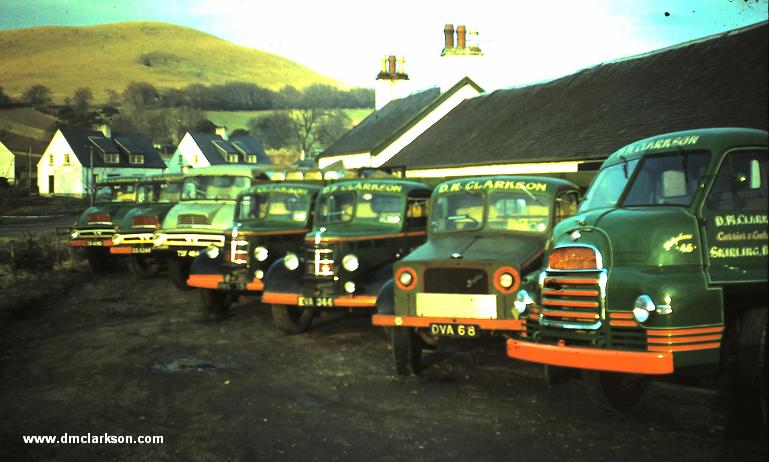
By the early 1950s the overnight parcel and pallet networks
were starting to establish north of the border, albeit on a
smaller scale than todays large operations. They were often
referred to as hub and spoke distribution. D M Clarkson Ltd
was a shareholder in a company based in Edinburghs Grassmarket
district, which acted as a co-operative for several other
smaller carriers working in central Scotland. The firm was
called Carriers (Clearance) Depot Ltd and employed a man to
take telephone messages from customers in the city and then
relay that message to the appropriate carrier for the delivery
area of the consignment. For example a mother in Biggar
could arrange to have her childrens luggage sent to and
from a private school in Perthshire by having the trunks
transhipped in the Grassmarket via a Perth carrier. Likewise
a wine merchant or brewery in Edinburgh could telephone
Fountainbridge 4021 any morning, and the driver would pick
up these calls around noon when most vehicles would stop nearby
for a lunch break and a brief gossip, and collect the consignment
that afternoon.
During the 1960s, D M Clarkson acquired John Hogg Carriers,
a local company also based in Biggar. This made good sense
for the future expansion of the firm, as Hogg had already
established reliable links serving Glasgow and the rest of
Lanarkshire. The business also had two further carrier
quarters at Bell Street and Hutchison Street in the city
centre, similar to the Grassmarket operation in Edinburgh.
This greatly increased D M Clarksons sphere of operations,
and the Renfrew feed mills in particular generated a steady
flow of trade for the local agricultural merchants.
It was around this time that David Clarkson also reorganised
the companys fleet. During the early days the fleet mainly
consisted of six-cylinder petrol Bedfords. However, it proved
to be more efficient to switch to diesel engines, like the
Perkins P6 or Ford D four cylinder as fitted to the Fordson
tractors of the time. A couple of Fordson Traders were bought
in 1959, but were replaced the following year by Bedford S
types equipped with 300 cubic inch diesels.
The company stayed loyal to Bedford throughout the sixties,
acquiring several TK models. By this time the lorries were
all fitted with two-speed axles that transformed the vehicles
performance. However, problems occurred with the speedometer
cable that ran via a small correction gearbox to deal with
the final drive ratio change from low to high. The correction
gearbox didn?t always change at the same time as the axle,
leading to exceptional speedo readings. Fortunately there was
no tachograph to worry about at this time and drivers learned
from experience to estimate the road speed. This was helpful
especially when travelling empty or downhill.
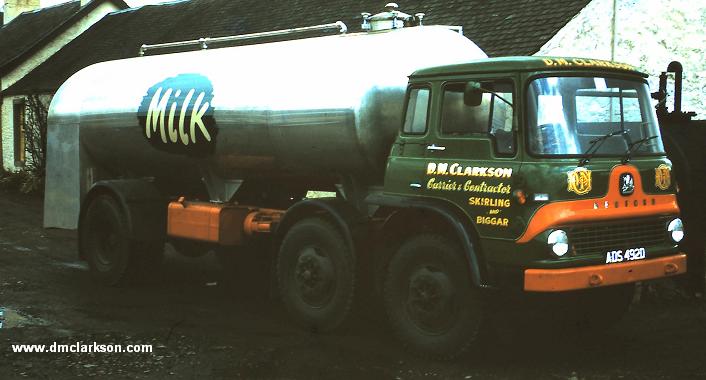
There were other changes. Payloads were gradually increased
and at least one Bedford KG was acquired with a York third
axle conversion fitted with a 370 cubic inch Power Plus
Leyland engine to keep it rolling. Another KH model was
specified with a Primrose twin-steer conversion powered by
a Leyland 400 and five speed Turner gearbox. As the 10
gallon milk churns were gradually phased out, the original
Bedford two speed lorry axle was also replaced with an Eaton
equivalent and the lorry fitted with a 2200 gallon bulk milk
tank. This initially caused a few problems as the original
Bedford handbrake, which was mounted on the gearbox output
shaft, was supplemented by cable operated hand brakes on the
new steering axle all operated by the original Bedford
handbrake lever.
When the new KM model was introduced with full air brakes
and spring handbrake cylinders in the late 1960s, the problem
seemed to have been solved. However the 466 cubic inch engines
were not reliable and the power steering boxes were forever
leaking oil. Subsequently, these vehicles were replaced with
Leyland Clydesdale and Reiver models, fitted with cabs made
in Bathgate. The engines were Leyland 401 or 410 types.
After a number of attempts to acquire a reliable vehicle,
a novel bespoke vehicle was built. A firm in Manchester was
found that specialised in taking older A series eight-wheel
ERF chassis and converting them to a double-drive six wheel
configuration by re-conditioning and replacing parts as required.
The result was a virtually new vehicle capable of taking a new
registration number. The cab was new from Middlewich and the
engine was a Gardner 6LXB mated to a David Brown six speed
constant mesh gearbox. All the brake parts were also new.
The end result was both economical to buy and operate and
led to a long association with ERF latterly with Cummins 11
litre engines. Of course, this sort of mix and match would
not be possible in the current climate of EU type approval.
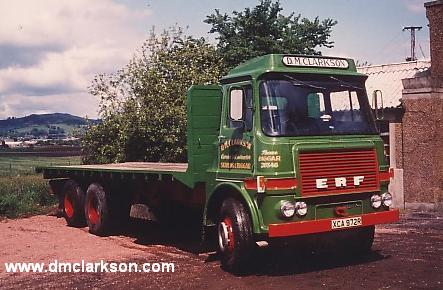
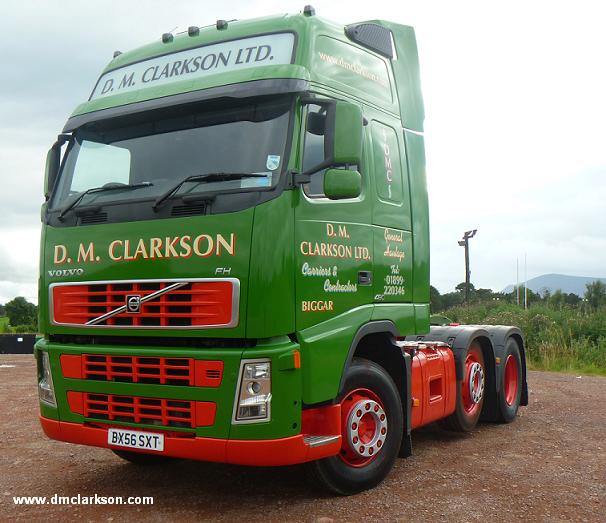
|
|
Borderline Garage, Hartree Road, Biggar, South Lanarkshire, Scotland ML12 6JJ,
|
|
Telephone: 01899 220551, 07825 013196
|
|
Website: www.dmclarkson.com
Email: dmclarksonltd@gmail.com
|
|
Company No. SC244556
|
|
© D. M. Clarkson Ltd 2021
|
|
Last Updated: Oct. 2021
|
|
|
|
|
|